Introduction
When we last saw Cerberus, the small form factor, low power, high performance IDS firewall, it was chewing through anything the net threw at it. Today’s question is: can Cerberus go for the gold and become a full-fledged Unified Threat Management (UTM) Appliance, capable of providing all of the protection required by a home network, let alone an enterprise network?
Cerberus, as the previous article detailed, is an IDS
Firewall built around a mini-ITX 1.8 GHz dual-core Atom and 3 GB of memory, providing three heads of network protection: pfSense, a free open source project, providing standard perimeter firewall protection as part of an overall router, and two pfSense packages: Snort, the premiere open source Intrusion Detection and Prevention rules engine, and IP Blocklist, which uses dynamic categorical lists to block questionable traffic.
To build a capable UTM appliance, we first need to define what Unified Threat Management is. Once we understand that, we’ll step through adding and configuring those services to Cerberus, and finally look whether Cerberus can carry the weight or fall short in either functionality or performance.
What is a UTM Appliance?
The concept of Unified Threat Management is straightforward: on the outer reaches of your network perimeter, you install an appliance that stops all possible threats to your network, an über firewall, as it were. The fact of the matter is that UTM hardware is expected to completely overtake separate network protection hardware.The problem is there is no single definition of the services required in a UTM appliance. For example, one of the foremost makers of UTM appliances for the enterprise, Endian, lists an entire dense page of functionality. In comparison, Untangle, a small organization UTM, lists only about twenty functions.
So what do they have in common? For our purposes, a UTM appliance is something that offers Intrusion Protection Firewall, Anti-Virus, Anti-Spam, and Traffic Control features. Beyond this core protection, a UTM appliance generally includes some enterprise operation capabilities, such as load balancing, fail-over, and network wide caching and monitoring.
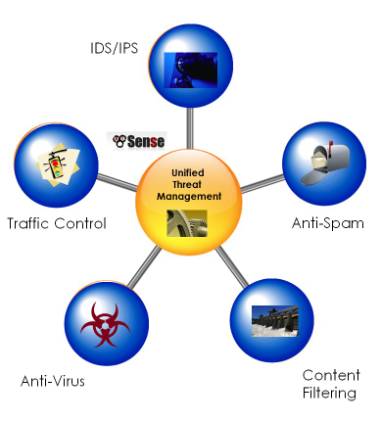
Intrusion Detection and Prevention (IDS/IPS)
 As detailed in the first article, IDS uses a packet inspection engine in conjunction with a standard NAT firewall to recognize patterns in network traffic, either at the packet level or at the stream level. IDS uses dynamic rules to spot these irregularities, such as protocol vulnerabilities, port scans, Denial of service attacks, and alike.
As detailed in the first article, IDS uses a packet inspection engine in conjunction with a standard NAT firewall to recognize patterns in network traffic, either at the packet level or at the stream level. IDS uses dynamic rules to spot these irregularities, such as protocol vulnerabilities, port scans, Denial of service attacks, and alike.The vast majority of UTM appliances utilize Snort, the most widely deployed IDS/IPS rules engine. Snort uses rules that are updated regularly from Snort.org. pfSense has wrapped Snort in an easy to install and administer WebGUI package.
Cerberus is already configured for Snort, so we’ll not be covering that as part of the upgrade process. For detailed instructions on how to install and configure Snort, please refer to the previous article.
pfSense Grade: A
Anti-Virus
The ability to block the Internet’s malicious flora and fauna from infecting network clients is core to any UTM. This is accomplished by inspecting packets for establish virus signatures and virus meta-patterns. pfSense includes the HAVP package: HTTP Anti-Virus Proxy, a transparent proxy that scans all HTTP traffic for malware signatures. HAVP utilizes ClamAV, the open source and community anti-virus engine for Linux and BSD distros.
pfSense includes the HAVP package: HTTP Anti-Virus Proxy, a transparent proxy that scans all HTTP traffic for malware signatures. HAVP utilizes ClamAV, the open source and community anti-virus engine for Linux and BSD distros. Naturally, the question of effectiveness is raised when using an open source anti-virus solution versus a commercial product. But is difficult to make a clear determination of effectiveness. Some reports place ClamAV in the top five, others in the bottom five.
There is a dirty little secret in anti-virus detection. Most anti-virus programs are good at detecting known malware. But with the preponderance of free Anti-virus solutions, virus writers are able to craft their code to avoid most prevention solutions, they can test their code before it is released into the wild.
This means that anti-malware solutions effectiveness should really be measured in latency, from the point that they are first seen in play, to when they are added to their respective detection databases. Commercial vendors run network scanners, honeypots, and have dedicated personnel associated with finding the newest threats. ClamAV does not have such resources and hence operates at a disadvantage.
HAVP, as the name implies, is also limited to HTTP traffic. This means that viruses imbedded in files transferred via FTP, HTTPS, and other protocols such as P2P are not examined and would not be detected. Neither are e-mail attachments scanned, which account for one of the largest causes of malware infections.
Because of this, it is important that UTM based anti-virus not be your only malware line of defense. Per client, anti-virus is a critical part of any network’s protection. With so many quality products that can be had at little or no cost, there is no excuse not to run anti-virus on each network host.
Additionally, since it is strongly recommended that you run only one anti-virus application per host, HAVP does have significant utility, because HTTP is one of the largest vectors for infection. HAVP gives you two bites at the apple and offers protection against malware that is targeted at closed systems, such as cell phones and Internet-enabled home theater components.
pfSense Grade: C-
Content Filtering
Content filtering is what it sounds like: the ability to block certain and generally NSFW content from your network. Such content is typically porn, gambling, file sharing, and hacking methods, but can extend to bandwidth-consuming audio/video sites and time-consuming social networking, forum, and blog sites.Most importantly, it can be used to block IP addresses associated with spamming, malware, and addresses deemed to be compromised in some other way. Unless you have kids, this is the category that is of the most interest to home networks.
pfSense excels at content blocking and offers four different packages for controlling what can come in your front door.
| Content Blocking Packages | ||
|---|---|---|
| DNS Blacklist | Included functionality uses a static category list | Domain blocking by category |
| Country Block | Add-on Package | Block entire country access |
| Squid Guard | Add-on Package, works in conjunction with Squid Caching Proxy Server | Full Featured URL filter |
| IP Blocklist | Add-on Package, uses frequently updated categorical address lists from IBlocklist.com | Block IP Addresses based on diverse set of lists |
Both Country Block and DNS Blacklist are simple. DNS Blacklist, which use a simple list of categories, is a real grab bag and allows the standard blocking of adult and gambling sites, but also astrology, and for some reason, French educational institutes sites (?!?).
IP Blocklist, which had its origins in the P2P peer blocking arena, blocks hosts that perform IP tracking for media companies and associations like the RIAA and the MPAA. It has grown to allow the blocking of spammers, advertising, malware, and other compromised sites. The lists differ significantly in quality; some are excellent, with spot-on targeting, while others seem ill-maintained, and hence have unintentional causalities - for example, one of the adware lists blocks all of CNet.
 The real star here is Squid Guard, which works with the caching proxy server Squid. Squid Guard allows for Access Control Lists for specific IPs, with scheduling and user-defined redirect pages. It comes with a built-in blacklist, but also allows the use of community-maintained categorical blacklists. Squid Guard is an ideal solution for café hotspots, schools and libraries.
The real star here is Squid Guard, which works with the caching proxy server Squid. Squid Guard allows for Access Control Lists for specific IPs, with scheduling and user-defined redirect pages. It comes with a built-in blacklist, but also allows the use of community-maintained categorical blacklists. Squid Guard is an ideal solution for café hotspots, schools and libraries.pfSense Grade: B
Anti-Spam
Unless you are running a domain out of your home, there is not a lot of call for anti-spam. However, for folks who run a domain’s mailserver, spam is a real problem. The current estimate is that over 75% of all e-mail traversing the net is spam.Spam traffic is a burden on any network, and as previously stated, e-mail accounts for one of the largest vectors for malware infection, either as attachments or through referred malicious web-sites.
pfSense does not currently provide an anti-spam solution. For that solution, you need to drop to the underlying operating system, FREEBSD, which offers numerous packages. There are two significant open source projects for controlling spam: SpamD and SpamAssassin. Notably, in the next release of pfSense, version 2.0, support for SpamAssassin is planned.
 The Perl-based SpamAssassin is a complex spam filtering tool, analyzing the e-mail stream for tell-tale indications that the mail being received isn’t legit. This includes the use of White and Blacklist to vet the e-mail. Beyond filtering, it also can be configured to use ClamAV for malware scanning of the e-mail payload. Depending on your e-mail load, this can be processor intensive.
The Perl-based SpamAssassin is a complex spam filtering tool, analyzing the e-mail stream for tell-tale indications that the mail being received isn’t legit. This includes the use of White and Blacklist to vet the e-mail. Beyond filtering, it also can be configured to use ClamAV for malware scanning of the e-mail payload. Depending on your e-mail load, this can be processor intensive.If on a whitelist, it passes the connection on to the proper mail processing daemon behind the firewall. If it doesn’t know the sender, it responds with a “Please Send Later” message, deferring delivery and adding the sender to the grey list. If the mail is actually resent later, the sender is added to the whitelist, and the mail connection passed on for delivery.
If the sender has been black listed, SpamD tarpits the connection, very slowly and repeatedly asking for details, like a brain-damaged sendmail.
The grey list process counts on the fact that most spam is delivered by hit and run bots, and if delivery fails, the process will just move on. The black list process just screws with the process, slowing down or stopping the ultimate delivery of spam to recipients.
Notably, when it comes to threats, pfSense creates an overlapping field of fire approach with many packages working in conjunction to avert the success of a threat. With spam, Snort provides a set of spam/phishing rules. Country Block content filtering provides a list of the countries most responsible for spam (I personally don’t see a lot of correspondence from Korea, the number one source of spam).
IP Blocklist and DNS Blacklist both provide lists for blocking spammers. This is also true of content management where Snort has a set of rules defining inappropriate content. Phrases like “XXX Teen” and other more colorful words can trigger the source address to be blocked.
pfSense Grade: D
Traffic Control
Part of threat management is the ability to control traffic on your network. This includes Quality of Service (QOS) and protocol/application blocking such as P2P, IM, and Gaming or Tor proxy traffic. pfSense doesn’t provide a single point of traffic control. Snort provides protocol blocking – a set of rules that block specific traffic, like P2P.QOS, the allotting of particular levels of bandwidth to specific applications/hosts or protocols, is accomplished through a Traffic Shaping Wizard that allows you to both prioritize and limit different types or destinations of traffic. The Wizard is very good at simplifying a complex problem, but does not allow a high degree of fine tuning. Additionally, the current version of traffic is limited to single-WAN/LAN prioritization. Version 2.0 of pfSense, now in beta, allows for Multi-WAN/LAN configurations.
The pfSense traffic shaping wizard uses your real world speed to allocate bandwidth, and steps you through a series of pages that allow you to “Shape” specific traffic. These include VOIP, P2P, Gaming, and other application traffic such as HTTP, Instant Messengers, VPN, and Multimedia traffic. You are also allowed to penalize (limit) bandwidth for either a single IP or a Single set of IPs.
 The Squid Package is a tunable caching proxy server, which provides both a high speed cache, and the ability to throttle traffic. You can throttle all HTTP traffic, per host traffic, specific traffic by category such as binary or multimedia, or by specific user defined extensions, say avi, mp3, and zip extensions. You can also set maximum upload and download sizes to further limit bandwidth usage..
The Squid Package is a tunable caching proxy server, which provides both a high speed cache, and the ability to throttle traffic. You can throttle all HTTP traffic, per host traffic, specific traffic by category such as binary or multimedia, or by specific user defined extensions, say avi, mp3, and zip extensions. You can also set maximum upload and download sizes to further limit bandwidth usage..Another aspect of Traffic Control is the ability to encrypt traffic via a VPN.
Three different VPN standards are supported: OpenVPN, IPSec, and PPTP. Under the current version of pfSense, both PPTP and IPSec have NAT limitations, making OpenVPN the most flexible solution. These limitations are well documented and a thumbnail of the issues is covered on the pfSense Capabilities Page.
pfSense Grade: B
Enterprise Capabilities
To paraphrase Doctor Strangelove, “What use is threat management if you don’t have a network?” Safe network access has become indispensable. Any primary network gateway needs to provide for failover, at both the hardware and the provider level.pfSense provides for hardware failover, network load balancing and failover, and a plethora of ways of monitoring its current and historical status. Hardware failover is handled through synchronized clustering of two separate pfSense boxes, utilizing the pfSense package CARP. Setting up CARP is outside the scope of this article (I don’t have two pfSense boxes, but it appears to be straightforward).
pfSense has built -in Multi-Wan failover and load balancing, utilizing three tiers of cascading gateways: a single load balancer gateway and a gateway for each ISP fail-over point, each having a separate ping heartbeat (say the IPs for Google or Yahoo) that points to the gateway to the ISP. Here is the diagram from the pfSense tutorial.
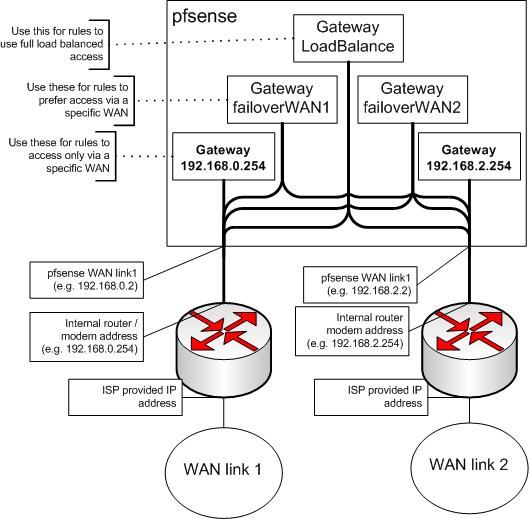
Fail-over is pretty straightforward, active standby is dead simple. The tricky part comes with load balancing, which uses a connection-based simple round-robin algorithm.
Quite a few applications/protocols are stateful when it comes to your IP address, such as P2P, games, and IM applications. For each of these you’ll need to set up routing rules that bypass the load balancer and direct the traffic through a particular ISP.
With HTTP connections, pfSense attempts to be sticky, that is, routing the same host through the same ISP, but this is hit and miss. You may see problems with web sites that count on your IP Address not changing, such as cloud based e-mail services and banks.
Regretfully, in the current stable version of pfSense, On-Demand connections, passive standby—like using USB Wi-Fi modems—is not currently supported. But this has been added in version 2.0. Without passive standby, failover is not very attractive to home networks, unless you are willing to incur two ISP bills a month. If you are, then load balancing becomes compelling, even with the routing hassles. Who wants to pay for bandwidth they don’t use?
Enterprise capabilities would not be complete without talking about monitoring, pfSense offers out-of-the-box Syslog and SNMP logging, and several adaptor packages for other protocols, such as RADIUS, NetFlow, and Zabbix protocols. For bandwidth monitoring there is both RRD and a mostly integrated BandwidthHD web display, which breaks out traffic by host IP.
pfSense Grade: C
Closing Thoughts
One important factor that can’t be ignored is that up-to-date content is needed for a UTM appliance to do its job. Without regular updates of IDS rules, host lists, and malware signatures, threat management is no better than a firewall.For commercial vendors of these appliances, this is a major source of revenue. With pfSense, this content is largely free – making pfSense, with all of its patchwork flaws, very compelling. The value proposition of pfSense is significant. It is free, open, and no expensive subscriptions are needed to protect your network. Free something is better than nothing. So in Part 2, I'll step you through adding and configuring these UTM features to pfSense.
Introduction to Multi WAN Interfaces
Introduction
In Part One of this series, we established a working definition of our target, i.e. what has to be done, and in what order, to Cerberus the lowly IDS firewall to make it a UTM Appliance.Once we have everything set up, we’ll look at performance and see if Cerberus with PFSense is able to be called a UTM appliance. But first, we need to attend to some prerequisites, which include setting up a second WAN interface for load balancing and fail-over and installing Squid, a critical piece needed for content filtering and anti-virus.
Multiple WAN Setup
For the purposes of this upgrade, we’ve ordered service from another ISP. You may remember we had previously set up a little-used guest wireless interface to use for our second ISP WAN connection for testing. Now we need the real thing.The setup is straightforward—enable the interface using parameters provided by your ISP. In most cases this is just DHCP. Note, the FTP Proxy should be disabled on all WAN interfaces, including this one. Figure 1 shows the settings.
 Figure 1: Enabling the second WAN interface
Figure 1: Enabling the second WAN interface
You can test your second WAN interface by changing the gateway on the already-established LAN routing rule, the one that directs LAN traffic through our current default gateway. Get the gateway for OPT1 from Status Interfaces, then under Firewall->Rules, edit the LAN rule, changing the gateway drop-down value to the OPT1 gateway IP as shown in Figure 2.Figure 2: Testing the second WAN
Now from a web browser, visit the GRC Shields-Up Site. Your IP should correspond to your IP address from the secondary ISP. If you can’t reach any web site, verify that the link is active by going to your modem/router diagnostics.If the IP Address corresponds to your primary ISP, turn on logging for the routing rule, close your browser, and reboot your installation. Check the log once you are back up. If you still don’t see the new IP address, verify your gateway settings. But hold off changing it back to the default gateway until after we’ve tested our IDS changes below.
That’s it, done. We can now hang Snort on the Secondary WAN interface and set up the needed proxy servers. Load balancing and failover will come later.
Install Squid
Squid provides a tunable HTTP cache with traffic throttling. As with all cache servers, it trades disk I/O for network I/O. Your performance gain is largely dependent your bandwidth, the number of users, traffic volume, and the diversity of that traffic.Significantly, there is a pretty cool chain here, and Squid is the heart of the whole thing. HAVP, the anti-virus proxy, runs as the parent of Squid, which in turn uses SquidGuard to filter content. All web requests travel through Squid’s cache that contains (at least) twice-filtered content. This saves both bandwidth and scanning cycles for any subsequent reference to that content.
All packages are installed through the Packages menu on the System pull-down. Once installed, you need to configure Squid from Services->Proxy Server. We need to configure General settings and cache settings.
Most of the General settings are self-explanatory and PFSense has a tutorial to assist. The easy answer is that five fields have to be set as shown in Table 1.
| Setting | Explanation | Value |
|---|---|---|
| Proxy Interface | Interface Squid is bound to | LAN |
| Allow Users on Interface | Do not require separate subnet enumeration. | Checked |
| Transparent Proxy | Operate without separate network client configuration, everything through the proxy. | Checked |
| Log Store Directory | Where the logs live. | /var/squid/log |
| Proxy Port | Where other processes can find the proxy server, the default | 3128 |
Table 1: Squid general settings
Figure 3 shows the settings for Cerberus.Figure 3: Squid proxy settings
And Figure 4 has a few more.Figure 4: More Squid proxy settings
General Settings are now done. So save’ em and move on to the Cache Management Tab.We need to do some math before we determine cache size values. The temptation, since we have gobs of our 250 GB disk available, is to use a large chunk for web caching. The thing is that Squid uses an in-memory index to address the cache. So it is best to balance memory against disk cache size.
The Squid User Guide recommends 5 MB of memory for every Gigabyte of disk cache (you don’t want to be thrashing, incurring a high swap rate). So determine how many megabytes of memory you have to spare for caching, divide that by 5, and you have the number of Gigabytes you should allocate to your cache.
With Cerberus under load and largely due to Snort, I run at 80% memory usage (according to System->Status), giving me about 600 MB free. I want some headroom for processing peaks, about half, so I have 300 MB available for my in-memory cache. Dividing that by the 5 to 1 guideline, I end up with a disk cache size of 60 GB.
Having calculated our sizes, we are ready to fill in the Cache Management configuration tab values, as summarized in Table 2.
| Setting | Explanation | Value |
|---|---|---|
| Hard disk cache size | Disk size limit in megabytes | 61400 |
| Hard disk cache location | Where the cache is stored | /var/squid/log |
| Memory cache size | Megabytes of memory cache | 300 |
| Minimum Object Size | Smallest object to cache, in kilobytes. | 0 (no limit) |
| Maximum Object Size | Largest object to cache, in kilobytes | 256 |
Table 2: Squid Cache Management configuration tab values
I have also tweaked the optional tuning values: used threaded access to the UFS file system and since I have cycles to spare and a large cache, I’ve doubled the number of level 1 directories. I’ve also changed the memory replacement policy to Heap-LFUDA (Least Frequently Used with Dynamic Aging).Figure 5 shows the settings for Cerberus.
Figure 5: Squid Cache Management settings
To verify your Squid install, check the System Log (Status->System Log). If you need to track down any issues, there is a more detailed log you can use. Execute a BSD command (Diagnostics->Command) to access it; it is located here: /var/squid/log/cache and should look like Figure 6.Figure 6: Squid cache.log
Additionally, to review web accesses, you can take a look at the access.log file in the same directory. Or install the partially-integrated Squid reporting tool, LightSquid, which gives you a view of cache hits, including Top Sites and hit percentages.With Squid installed, we are done with the prerequisites. Let’s start the main event, the functional upgrades needed to become a UTM.
Building Own IDS with Pfsense
Intrusion Detection and Prevention Configuration
Cerberus is already an IDS Firewall. In the previous article Build Your Own IDS Firewall With pfSense the installation and configuration of Snort was covered in detail. So there is little that needs to be done further for it. We do need to add our new OPT1 WAN connection, however and rearrange our rules.We are going to want the same overall protection on both WAN interfaces. So under Services->Snort, add both the new OPT1 interface and your LAN interface. The OPT1, Secondary ISP interface should be a clone of your Primary Interface, i.e. same pre-processor settings, same rules, as shown in Figure 7.
Figure 7: Squid interfaces
The LAN interface, on the other hand, is lightweight with just the pre-processor defaults and HTTP Inspect checked. It should handle just a few categories of rules. The idea here is to offload a few categories from your WAN interfaces to the LAN's where it would be good to know which LAN IP is being attacked and whether the attacks are coming from the inside. Examples categories would be NetBios and ICMP.Your mileage may differ and you may want to expand the categories that generate alerts. Figure 8 shows the selected categories on Cerberus.
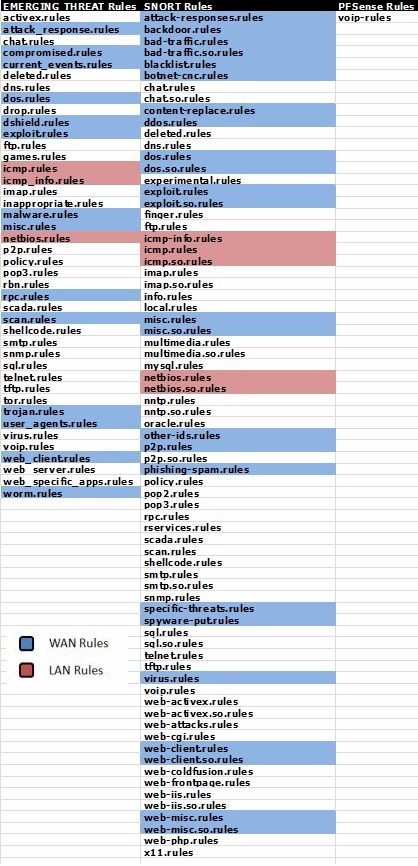
Figure 8: Alert categories
Remember, the more rules you select, the higher the probability of false positives, which can be an administration headache.After adding the additional interfaces and configuring them, start Snort by clicking the green arrow next to the interface definition. We can test these additions to Snort by using the GRC Shields-Up Site to scan the added Secondary ISP WAN interface. Your Snort Alert log should look something like Figure 9.
Figure 9: Snort Alert log
If you have an ISP-provided router instead of just a modem, you need to either put pfSense in the DMZ or configure your router to run as a transparent bridge.Since ISP routers are a known attack vector, transparent bridging is recommended.
For example, out of the box, the Qwest branded Actiontec Q1000 has multiple ports open, including HTTPS for remote administration. For the purposes of obscuring my logged IP address in this article, Cerberus has just been put in the DMZ.
Once this is complete, you will want to reverse the changes made when testing your multi-WAN configuration and change your LAN traffic rule back to using the default gateway (our primary ISP).
Anti-Virus Install with pfsense
HAVP, our anti-virus solution, has pretty much a point and shoot setup. Once installed, there are only a few settings (Services->Anti-Virus) to change on the HTTP proxy tab:| Setting | Explanation | Value |
|---|---|---|
| Enable | Turn on scanning | Checked |
| Proxy mode | Define Run Mode | Parent of Squid |
| Proxy port | Connection Port. Must be different than Squid port | 3125 |
Table 3: Anti-virus settings
There are several other discretionary settings including file types to scan, logging, etc. Figure 10 shows the settings for Cerberus.Figure 10: HTTP proxy settings for anti-virus
And a few more in Figure 11.Figure 11: More HTTP proxy settings for anti-virus
There are also some minor settings under the Settings tab dealing with update frequency and logging. Figure 12 shows how Cerberus is configured.Figure 12: Miscellaneous AV settings
Once you have saved your settings, you can verify that both the HAVP proxy and the ClamAV scanning engine are running under the General page tab:Figure 13: HAVP and ClamAV running
Once you are fully updated (should take about ten minutes), you can test your install using safe virus simulation files provided by Eicar.org.Figure 14: Eicar.org virus test file
Only two of the test files are recognized as threats. Files with the extension COM are not scanned, and embedded archives are not tested, underlining the need for separate anti-virus on each host machine.Anti-Virus is now up and running.
That's it for this installment. Next time, we'll continue the conversion to UTM with Content Filtering setup and plenty more.
Introduction to content Filtering squid guard
Content Filtering
In addition to IP Blocklist, there are two very simple packages to install: Country Block and DNS Blacklist. Country Block is geared towards blocking the countries responsible for the highest volume of Spam, but can be used to block the Individual countries. It uses the national CIDR ranges from CountryIPBlocks.net.
Once installed, it is simple to configure. Select the countries you wish to block from a list of all countries. At the top, you’ll find a list of countries responsible for the largest volume of spam. Enable the service, select the countries you want to block, commit your selections, and save. Done.
Figure 1: Country Block configuration
Incoming traffic is blocked by default, but this can be changed along with logging on the Settings tab. You can also limit blocking to a particular interface, but it defaults to all interfaces.The other simple package, DNS Blacklist, allows you to block specific categories of domain names. The package forces DNS to resolve all domains listed in the selected categories to Google's IP address. The categorized domain list is originally from the Université Toulouse 1 Capitole, and has been wrapped into the release. This means the lists are static, and are not updated regularly, limiting overall usefulness, unless you choose to update them manually.
Figure 2: DNS Blacklist configuration
DNS Blacklist offers a very lightweight alternative to the content filtering heavyweight, Squid Guard. It uses DNSMasq as a DNS Forwarder, so requires no proxy server or complex indexing.SquidGuard
The other alternative to content filtering is SquidGuard, a full bodied content filtering system that has more controls than a Gemini space capsule and is just as hard to get in and out of. To complicate this further, the SquidGuard tutorial on pfSense.org has gone 404.Even with the difficulties of configuring SquidGuard, the functionality is compelling. You can choose what to block, for whom to block it, from what time to what time should the whole block thing happen, per entry.
The initial setup is a bit convoluted and requires a bit of dancing. First, you should select the blacklist provider you want to use. A meta-list is available from SquidGuard.org. The recommended set of lists is Shalla's Blacklists (List Archive: http://www.shallalist.de/Downloads/shallalist.tar.gz ).
Starting with the General tab (Services->Proxy Filter), enable the blacklist and paste the URL of your list archive, a tarball, into the value for Blacklist URL. Go ahead and save without enabling SquidGuard yet.
Figure 3: SquidGuard General Settings
Now move to the Common ACL tab. The common access control list handles filtering policy for everyone, and by default, web access is denied. We need to set it to ALLOW before enabling SquidGuard, otherwise we would lose all web access.Expand the Target Rules List, there should be one entry, Default Access, set this to ALLOW and save.
Figure 4: SquidGuard Common ACL setting
We are still not ready to turn the key yet. We need to go get our blacklists, so move to the Blacklist tab. If the URL field doesn't contain your selected list URL, copy it from the General tab and download the list. It will be downloaded and loaded into SquidGuard database. Wait for the download to complete; this may take up to ten minutes, depending on the list archive.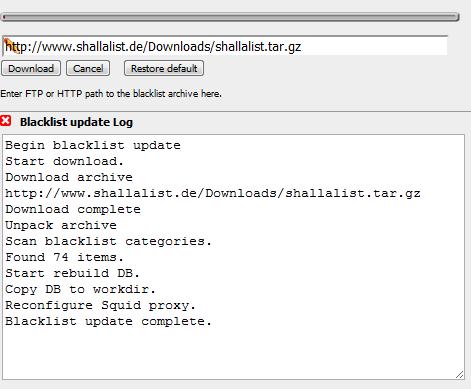
Figure 5: Blacklist download
Once we verify we have a blacklist, we will be ready to kick-start this beast. Return to the Common ACL Tab and expand the Target Rules List. It should look like this now:Figure 6: SquidGuard Common ACL Target rules
Now return to the General Settings tab, check all the logging you can, and check Enable. Save these changes and wait for the SquidGuard Service State to change to Started.To verify that it is up and running, check the Filter Log under the Logging tab. If all looks good, go to the Common ACL tab and set the blacklist blk_BL_hobby_pets to DENY and Save. Return to the General Settings tab and click Apply. Now, try to go to the French Bulldog Club.
You should see:
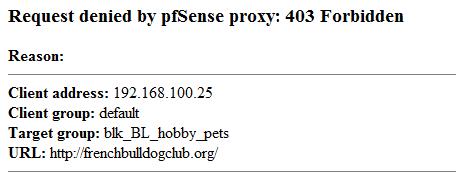
Figure 7: URL denied
This is just the tip of the iceberg for SquidGuard. For example, it would be possible to redirect any references to the Fox News site to that of the NY Times, from 9 AM to 9:10 AM ...on only Karl the programmer's machine. Or more importantly, ensure that your kids are actually using the Internet to do their homework after school, instead of Facebook.Traffic Control
Though Traffic control is central to pfSense, there are some serious limitations in the current version. Traffic shaping in Version 1.2.3 doesn't handle either Squid HTTP traffic or failover. (Squid uses your loopback interface, which is not shaped, but there is a workaround). Version 2, to be released soon, supposedly does.Traffic shaping can be effective on a single WAN system or multi-WAN, but just on a single WAN interface with static routing. For example, you can direct all file transfer protocols (P2P, FTP, etc) through your secondary WAN interface, and leaving HTTP on the primary interface.
I will introduce traffic shaping. But full traffic shaping is complex, requiring specific details of not only your traffic, but of use patterns. This kind of traffic shaping is outside the scope of this article; more details can be found in the pfSense forums.
The Wizard sets up initial traffic queues and rules that can then be tuned; it uses your actual bandwidth figures to allocate traffic across the defined queues. So, before you start, you will need to gather your bandwidth figures, both up and down, using any number of sources (DSLReports, for example).
The first time you go to the Traffic Shaper (Firewall->Traffic Shaper) you will be presented with the wizard interface, which will step you through setting up traffic queues for the traffic you want to shape.
Figure 8: Traffic Shaper Wizard
Here are the options for types of traffic that can be prioritized:| Traffic Type | Description |
|---|---|
| VoIP | Higher priority for VOIP traffic, generic or Vonage, Voice Plus, Asterisk |
| Peer To Peer | Allocate Bandwidth to generic P2P traffic, or Disable and Lower priority for about 20 protocols of P2P traffic |
| Gaming | Increase priority for about 20 Games, including BattleNet, WOW, Xbox360 |
| Other | Set priority for about eight categories including VPN, IM, HTTP, and Multimedia |
Table 1: Traffic Shaper options
You can also define a Penalty Box, a specific IP or alias to limit if traffic levels are high.Once you finish the wizard, it will generate traffic queues, which are essentially separate sets of routing rules. When you return to the Traffic Shaper, you will now have three tabs: Rules;Queues; and a tab for rerunning the wizard.
Figure 9: Traffic Shaper queues
The values and order of the rules can all be tuned to prioritize traffic. By editing a queue, you can change the traffic percentage, and the corresponding priority of the traffic.To verify that traffic is moving through your queues, go to the Queue Status page (Status->Queues). The various bar graphs should dynamically show changes in traffic patterns after a short delay. Attention should be paid to any drops, which indicate traffic problems.
Figure 10: Traffic Shaper queue status
Both Squid and Snort offer traffic control facilities. Squid offers both transfer caps and throttling under the Traffic Management tab of the Squid page (Services->Proxy Server). These settings are straightforward, and allow for throttling of particular categories of downloads.Figure 11: Squid traffic management
Snort, on the other hand, offers rules for blocking certain protocol traffic , such as IM Traffic (emerging and snort chat.rules) and P2p traffic (snort and emerging p2p.rules).Load Balancing & Failover
Now we are going to set up load balancing and failover. Let's look at the diagram from the pfSense tutorial again, and gather our required parameters before we begin.
Figure 12: pfSense block diagram
| Interface | IP address | DNS address |
|---|---|---|
| Gateway Primary ISP (WAN) | 192.168.100.100 | 68.105.28.12 |
| Gateway Secondary ISP (OPT1) | 192.168.0.2 | 205.171.3.25 |
Table 2: IP address assignment
There are five steps to setting up failover and load balancing, one of which we have already accomplished.- Set up Multi-WAN Configuration – done in Part 2.
- Set up Required Values – List DNS Servers, Turn on Sticky Sessions
- Define Failover Gateways – One for each WAN connection
- Set Up Load Balancing Gateway – Handles Round Robin Traffic Assignment
- Define Rules for LAN Traffic – Direct LAN Traffic to Load Balancer
Since we have already set up Cerberus for multi-WAN, we'll jump to step two, setting values. We need to do two things here; the first is make sure the two DNS addresses we are going to be using (68.105.28.12, 205.171.3.25) are listed under General Setup.
Figure 13: DNS address assignment
In Advanced Setup, we want to turn on sticky connections, so traffic started on a particular ISP WAN interface stays there, preventing sites that use your IP Address, such as your bank, from getting confused.Figure 14: Enable Sticky Connections
I also recommend editing your Snort Whitelist (Services->Snort), ensuring DNS servers are automatically added. Depending on your ISP, DNS irregularities may cause Snort to block them, giving you a false failure.Figure 15: Snort Whitelist auto-add DNS servers
The next step is setting up the failover gateways in the Load Balancer (Services->Load Balancer). Each failover gateway has a pool of interfaces, each with a monitoring IP. We have two pairs of Interface and Monitor IPs that need to be added to each pool. The only difference between the two gateways is the order of these pairs.Pair One is the Primary ISP, and the WAN DNS Server: [ WAN, 68.105.28.12 ]
Pair Two is the Secondary ISP, and the OPT1 DNS Server: [ OPT1, 205.171.3.25 ]
The first pair in each gateway is the opposing interface, the one that it fails over to. The second is its own Interface. So the pools look like:
Figure 16: Failover gateway address pool
Here is the pool setup for the Primary ISP, note the the Secondary ISP Failover gateway only differs in pair order:Figure 17: Primary Failover pool IP setup
With the failover gateways up, we can define the load balancer gateway – this looks just like our 2ndWanFailover gateway, except the behavior is Load Balancing instead of Failover.Figure 18: Load Balancer gateway setup
With that, we have completed our Gateway setup:Figure 19: Gateway setup complete
Load Balancing & Failover - more
The final step is to start routing traffic through the load balancer. For that ,we need to define three firewall rules:| Rule | Explanation | Order |
|---|---|---|
| Primary ISP Traffic | Drive traffic to your Primary ISP | First |
| Secondary ISP Traffic | Traffic Destined for Second ISP | Second |
| Load Balancer Traffic | Direct Traffic across ISPs | Last |
Table 3: Load balancer rules
| Action | PASS |
|---|---|
| Interface | LAN |
| Protocol | ANY |
| Source | LAN subnet |
| Destination | Network, 192.168.100.0/24 |
| Log | Yes ( For Testing) |
| Gateway | Default |
Table 4: Primary ISP Traffic rules
For the secondary rules, we just change the destination:| Action | PASS |
|---|---|
| Interface | LAN |
| Protocol | ANY |
| Source | LAN subnet |
| Destination | Secondary ISP Subnet |
| Log | Yes ( For Testing) |
| Gateway | Default |
Table 5: Secondary ISP Traffic rules
For the Load Balancing Rule, we want any traffic that doesn’t have a determined destination to go through the load balance gateway:| Action | PASS |
|---|---|
| Interface | LAN |
| Protocol | ANY |
| Source | LAN subnet |
| Destination | ANY |
| Log | No |
| Gateway | LoadBalance |
Table 6: Load balancer Traffic rules
This is what your finished rules will look like:Figure 20: Firewall rules complete
To verify that everything started properly, go to the Load Balancer status page (Status->Load Balancer). It should be all green:Figure 21: Load Balancer ready
Before we go any further, we should test load balancing and failover. Remember,Squid and HAVP are not multi-WAN enabled. These packages use a single interface and bypass the load balancer to push traffic out the interface you configured it to use, in our case the WAN PrimaryISP interface. So to test failover we’ll take down the SecondaryISP by simply disconnecting the cable. The system log should record the failure:
Figure 22: Log showing failover event
If the failure is not logged, or shows the wrong interface, most likely you’ve confused your pairs, using the wrong DNS address.To test load-balancing, use a protocol other than HTTP, say FTP, POP, IM, etc. that doesn't go through Squid. You should see the rule trigger on the balancer gateway in the firewall log:
Figure 23: Load Balancer rule trigger
You can also check your States Table (Diagnostics->States). It should list some states associated with your Secondary ISP if load balancing is working.Your network should now be ready for the next unplanned outage by your ISP.
Sticky Connections solves most requirements for persistent sessions, but you may want to do your own pre-emptive load balancing, especially if you will be running a proxy server such as HAVP and Squid. The template for these rules is:
| Action | PASS |
|---|---|
| Interface | LAN |
| Protocol | TCP |
| Source | LAN subnet |
| Destination | ANY |
| Destination Port | HTTPS |
| Log | No |
| Gateway | 2ndWANFail |
Table 7: HTTPS Rule for Balancer Bypass
The HTTPS Destination Port in Table 7 can be FTP, SMTP, etc. This rule needs to be at the top of the list of rules—the load balancer rule should always be last. Using a failure gateway, traffic will, of course, fail over. If that isn’t what you want, change the gateway address to use the direct Gateway instead. In our example, that is Opt1/192.168.0.2 or WAN/192.168.100.100.P2P traffic is much the same. You will have to use a static port and the destination port will need to agree with the configuration of your BitTorrent client (uTorrent uses 2000-3000). For incoming connections, you’ll need to define a port forwarding rule on your NAT, instead of using UPnP. More details are available in this pfSense tutorial.
That's all for this time. We'll try to wrap this up next time and run some performance tests to see if our hardware platform can handle all the extra duties we have piled onto it.
Monitoring Logging
Above of this post, we established a working definition of our target, i.e. what has to be done, and in what order, to Cerberus the lowly IDS firewall to make it a UTM Appliance. In above, we started the conversion by installing and configuring multi-WAN support,
Squid, IDS and anti-virus features. above , we added and configured Content Filtering, Traffic Control, Load Balancing and Failover.
In this last part, we'll wrap things up with Monitoring and Logging configuration, performance testing, final grading and reflection on the whole process.
Monitoring and Logging
There are numerous packages for logging and interfaces to external monitoring packages, summarized in Table 1.| Capability | Explanation | Features |
|---|---|---|
| Built-in Logging | Protocols for logging system events | SNMP, Syslogd, WebGui |
| RRD Graphs | System Resources Graphic Monitoring Tool | CPU Load, Traffic Throughput, Quality Handling, and Shaping Queues |
| Snort | Alert Tracking and Status | Barnyard2 package interface, Dashboard Widget |
| Squid | Web and Cache statistic | LightSquid |
| System Status | Hardware and Package Status | Dashboard, PHPsysinfo, WebGui, BandwidthD |
| External Interfaces | Monitoring and Management Agents | Zabbix, Radius, ntop |
Table 1: Logging and monitoring packages
Several of these are built in, RRD Graphs are available is available from the Status menu, SyslogD can be configured there too, under Status->System Logs->Settings. SNMP is a built-in, find it under Services->SNMP.Installing the others is straightforward, and can be found in the packages menu, these include LightSquid, BandwidthD, PHPsysinfo, and the Dashboard, including several dashboard widgets (Snort, Havp status). The interface to Barnyard2 is included with Snort.
The only issue with a couple of these packages, LightSquid, ntop and BandwidthD, is that they are not fully integrated into the pfSense webGui - the pfSense banner and menus disappear, but backing out of the reports will lead you back to the web GUI.
Here are some screenshots of some of the logging and reporting options:
Figure 1: RRD Graphs
Figure 2: BandwidthD add-on Package
Figure 3: Dashboard
Figure 4: Light Squid
Performance
First, a bit of review. Cerberus was introduced in Build Your Own IDS Firewall With pfSense as an inexpensive build (around $350) for an IDS Firewall. The build list is in Table 2.| CPU | Intel Atom D525 (Pineview-D) Dual Core, 1.8GHz (13W) processor | Incl in mobo |
|---|---|---|
| Motherboard | Supermicro X7SPA-H-D525 Mini-ITX Server | $180 |
| RAM | 2 x non-ECC DDR3 1066MHz SO-DIMM (running @800MHz) | $50 |
| Storage | WD Scorpio Blue 2.5” 250Gig drive | $40 |
| Ethernet | Intel 10/100/1000 PCIe NIC | $30* |
| Case | Antec Mini-Skeleton-90 | $90 |
| DVD | Sony DVD-ROM | * |
Table 2: Cerberus component list
That previous article explained the whole decision process, the components and why. On top of that hardware we installed pfSense, Snort, and IP Blocklist – all to provide an extraordinary level of protection for a home network.As an IDS Firewall, Cerberus made a good showing, not a speed demon, but in the top third of SNB’s router performance charts. Running iPerf as the server on Cerberus, directly over gigabit LAN to jPerf, Figure 5 shows an average throughput of 236 Mbps, with a peak of 253 Mbps with a fair amount of CPU headroom left over.
Figure 5: Running iperf on Cerberus as IDS
And finally we added some minor packages, SpamD for anti-spam, and DNS Blacklist and Country Block for targeted content filtering, BandwidthD, Lightsquid and Darkstat for reporting. In all, a complete package, our UTM.
So how did Cerberus the UTM fare performance-wise? Let's look at Figure 6, running the same iperf test, under the same conditions that we used for our IDS Firewall.
Figure 6: Running iperf on Cerberus as UTM
This time, I measured an average throughput of 203 Mbps, with a peak of 231 Mbps; CPU hit a utilization of just over 80% with using about 93% of available memory. Not too shabby, only a 14% drop in performance, but without CPU headroom. This shows how much we overestimated the processing requirements of pfSense; a dual core Atom 510 would probably been sufficient vs. the D525.Conclusion
Without a doubt, Cerberus has been transformed. Take a look at the packages and features we have enabled in the summary Table 3.| Package/Feature | Pros | Cons |
|---|---|---|
| Snort IPS/IDS | Comprehensive, Quick Rules engine supporting dynamic rules | High Memory Demands, Requires both thoughtful configuration and administration |
| Squid Proxy Server | Fast capable proxy server, allows for traffic throttling | Not just point and shoot, doesn’t work with QOS |
| HAVP/ClamAV Anti-Virus | Non-Blocking, Easy to set-up | Not comprehensive, non-commercial AV scanning |
| pfSense QOS | Wizard-based setup, queue based administration | Limited Level-7 Support |
| pfSense Multi-Wan Load Balancing and Failover | Provides for resilient failover | Not integrated with QOS or packages, uses simple load balancing algorithm, complex non-intuitive set-up |
| Squid Guard Content Filtering | Full featured content filtering down to who and when, ability to use external well maintained lists | Difficult install, no stock blacklist, poor documentation |
| IP Blocklist | Dynamic list based blocking | Slow, manually updated list administration has bugs, lists can be a mixed bag |
| DNS Blacklist | Quick and simple category-based host blocking | Static list requires manual updating |
| Country Block | Easy and quick blocking of country CIDRs | Geared more towards anti-spam |
| SpamD Anti-Spam | Simple, clever spam protection | Not integrated into pfSense, set-up requires hacking |
| Reporting: RRD, BandwidthD, LightSquid | Comprehensive and easy to set up, dynamically updated | Not fully integrated into webGui |
Table 3: Cerberus UTM packages
So can Cerberus take home the UTM Crown? Have we hit our target? Let's take a look at the big picture. The first step is reviewing the summary of grades from| Function | Grade |
|---|---|
| Intrusion Prevention & Detection | A |
| Anti-Virus | C- |
| Content Filtering | B |
| Anti-Spam | D |
| Traffic Control | B |
| Enterprise Capabilities | C |
| Overall Grade | C+ |
Table 4: Cerberus UTM grading
I do feel this is an accurate grade, based on functional capabilities. But the overall grade does not reflect what you personally might need from a UTM - in that case the grade drops to that of your most urgent requirement. If you are being pummeled with spam, or run an environment with a lot of unknown users, where anti-virus is significant, the grade you give pfSense drops dramatically. If home network protection is most important, the grade gets much better.We could stop now, and say Cerberus is a UTM, sort-of. But that would be disingenuous, because of what we learned in the upgrade process. There are three other important aspects of our system in grading whether we hit our goal. These are: our installation experience; how well the system performs; and finally, the degree of integration, i.e. how well do the pieces work together.
The installation experience varied greatly, spanning the spectrum from seamlessly simple, with the installation of HAVP, our anti-virus solution, to the convolutions of origami we saw with installing SquidGuard, the cornerstone of content filtering. None of the more significant packages was what would be called turnkey.
It is understood that difference between an amateur and a professional is consistency - a professional chef makes the same dish over and over and it tastes the same, we cook at home, the meal can vary dramatically. PfSense’s install processes are not consistent.
pfSense Installation Process Grade: C-
Performance is the bright spot, even with several layers on top of our TCP/IP stack, a multitude of processes poking and prodding packet after packet, Snort, QOS, load balancing, and a couple proxy servers, Cerberus still rendered excellent performance.
pfSense Performance Grade: B
Now the big one, the degree of integration: the pieces just don’t meld together to form one appliance. Squid doesn’t work with QoS, HTTP traffic will remain unmetered. The reporting tools, LightSquid and BandwidthD, are only partially integrated into the webGUI. And most significantly, virtually none of the packages are compatible with the critical enterprise aspect of running multiple WAN connections, not the built-in QoS, not any of the various proxy servers.
pfSense Integration Grade: F
If a UTM is defined by the six functional groups we identified in Part 1 of this article, then yes, pfSense and Cerberus is a UTM, all the boxes are checked. But if a UTM is an appliance where all the pieces work together, are really unified, then no, we can’t say that Cerberus is a UTM. The whole must be bigger than the sum of the parts, or a checklist of functionality.
What we learned in this upgrade is that pfSense is a patchwork of packages, some excellent, others not so much. But overall, the pieces don’t gel. The updated scorecard in Table 5 calculates out to a C. But it feels more like a Fail, or if you are charitable, an Incomplete.
| Function | Grade |
|---|---|
| Intrusion Prevention & Detection | A |
| Anti-Virus | C- |
| Content Filtering | B |
| Anti-Spam | D |
| Traffic Control | B |
| Enterprise Capabilities | C |
| Installation Process | C- |
| Performance | B |
| Integration | F |
| Total Grade | C |
Table 5: Cerberus final UTM grading
This judgment, our final grade, only applies to our well-formed definition of what a UTM is, and does not imply that pfSense is not suitable for solving your problem, especially if you don’t need Multi-Wan. If all you want to do is protect your home network, Cerberus is an all-star.However, there is hope on the horizon. While writing this article, pfSense moved the long awaited Version 2.0 out of beta. 2.0 is reported to sport fully integrated multi-wan support, and expanded support for packages like SpamD. So we may get to do this all over again!






































Squidblacklist.org is the worlds leading publisher of native acl blacklists tailored specifically for Squid proxy, and alternative formats for all major third party plugins as well as many other filtering platforms. Including SquidGuard, DansGuardian, and ufDBGuard, as well as pfSense and more.
ReplyDeleteThere is room for better blacklists, we intend to fill that gap.
It would be our pleasure to serve you.
Signed,
Benjamin E. Nichols
http://www.squidblacklist.org
Hi there.. can the squid blacklist running on pfsense with bridgemode? I have one machine that setup in bridgemode but to block site such as facebbok and youtube it seems its not working in bridgemode or my config has gone wrong..Any suggestion and help is much of appreciation.thks
ReplyDelete